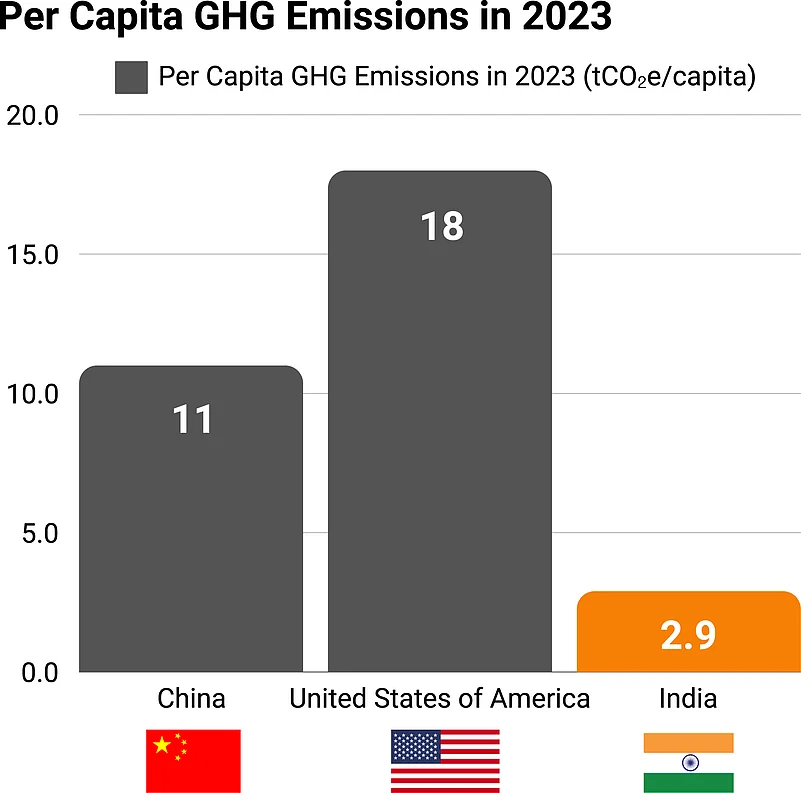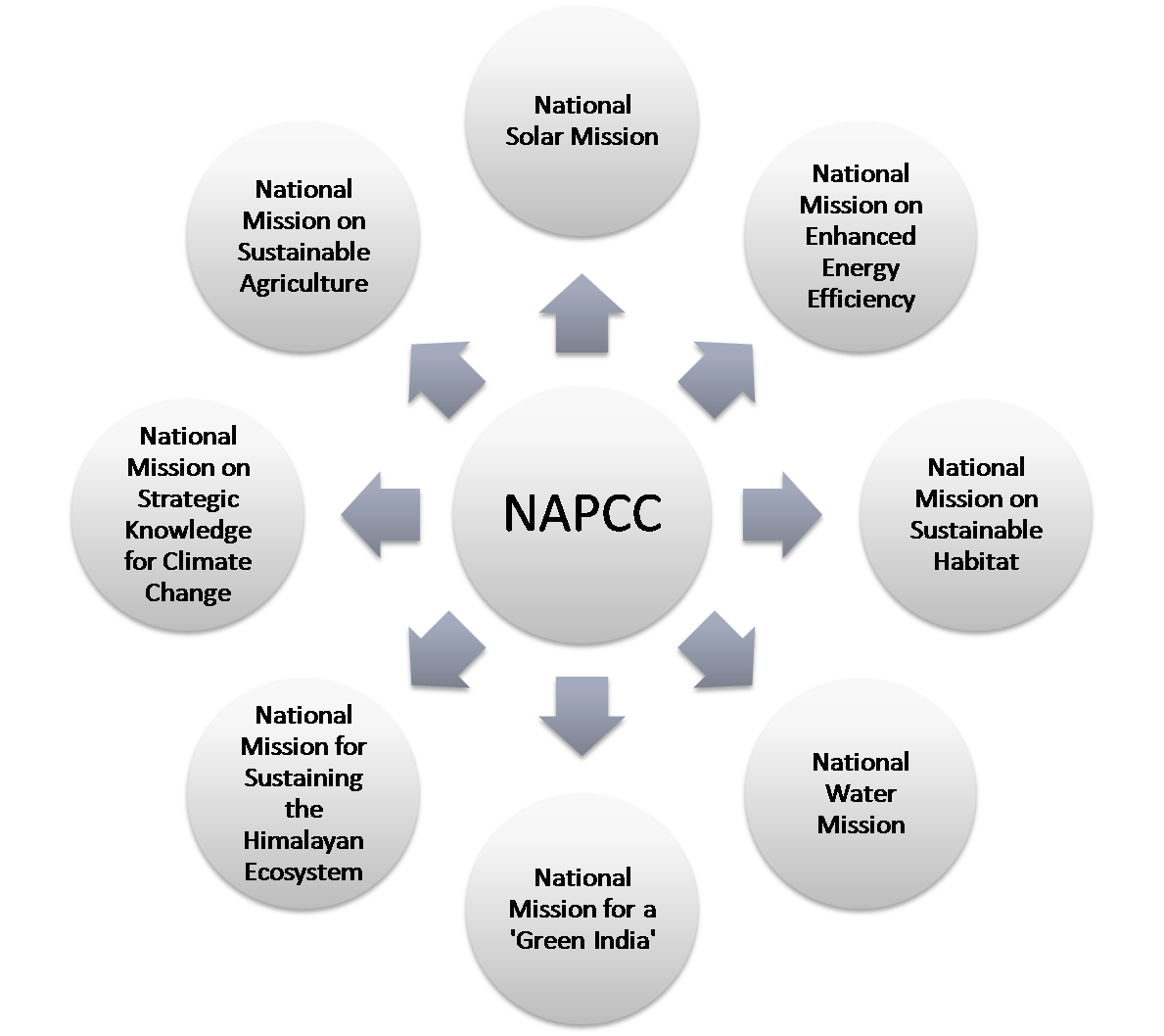



Copyright infringement not intended
Picture Courtesy: THE HINDU
India advocates the principle of Common but Differentiated Responsibilities and Respective Capabilities (CBDR-RC), which recognizes developed nations' greater accountability for climate change due to their historical emissions.
In 2023, India's per capita GHG emissions were 2.9 tCO₂e in 2023, lower than China (11 tCO₂e) and the US (18 tCO₂e), and far below the global average of 6.6 tCO₂e.
By advocating for climate justice, India can lead the Global South in demanding fair climate finance and technology transfer.
 Demonstrated Domestic Action and Ambition
Demonstrated Domestic Action and Ambition
India has achieved clean energy goal of 50% non-fossil power capacity by July 2025 ahead of schedule, proving leadership and progressing towards 500 GW non-fossil fuel capacity by 2030. (Source: PIB)
Economic Opportunity and Innovation Hub
India leads in climate action with 227 GW renewable energy capacity by June 2025, creating economic opportunities. (Source: PIB)
Indian conglomerates are investing in green energy, boosting shareholder value and establishing India as a global green technology hub.
Enhanced Soft Power and Geopolitical Influence
By leading on climate, India can enhance diplomatic leverage and soft power globally.
Initiatives like the International Solar Alliance (ISA) and the Coalition for Disaster Resilient Infrastructure (CDRI) are examples of India's proactive climate diplomacy, shaping global agendas and enhancing international cooperation.
India faces challenges in climate policy implementation due to financial limits, weak political will, poor institutional capacity, and low public awareness.
Global Geopolitical Complexities
Power struggles and unfulfilled financial commitments from developed nations hinder global climate action. India must navigate these geopolitical hurdles to advance a cooperative climate agenda.
What Has India Done So Far in Climate Action?
Nationally Determined Contributions (NDCs) & Panchamrit: At COP26 in Glasgow, India announced "Panchamrit" goals, and updated in NDCs submitted in August 2022. These include:
National Action Plan on Climate Change (NAPCC)
Launched in 2008, NAPCC frames eight missions: solar energy, energy efficiency, sustainable habitat, water, Himalayan ecosystem, green India, sustainable agriculture, and strategic knowledge for climate change.
 Key Initiatives and Schemes
Key Initiatives and Schemes
International Solar Alliance (ISA)
Mission LiFE (Lifestyle for Environment): Launched by Indian Prime Minister, it promotes a public movement to encourage individuals to adopt sustainable lifestyles.
Coalition for Disaster Resilient Infrastructure (CDRI): An India-led global initiative promoting the resilience of new and existing infrastructure systems to climate and disaster risks.
National Green Hydrogen Mission: Aims to position India as a global hub for green hydrogen production and export.
Reduced Emission Intensity: India reduced the emission intensity of its GDP by 36% between 2005 and 2020. (Source: PIB)
Perform, Achieve and Trade (PAT) Scheme: Launched in 2012, this market-based mechanism under the Bureau of Energy Efficiency targets energy-intensive industries to improve energy efficiency.
Carbon Credit Trading Scheme (CCTS): Introduced in June 2023, the CCTS is a pivotal step towards creating a transparent and regulated carbon market in India, capable of unlocking new finance streams for climate action.
Way Forward For India
Strengthen Domestic Implementation
Accelerate current climate policies such as the National Green Hydrogen Mission and renewable energy targets by enhancing financing, simplifying land acquisition, and improving grid infrastructure for greater renewable energy integration.
Champion Climate Justice and Finance
Advocate for the CBDR-RC principle and urge developed nations to fulfill their climate finance pledges, aiming for at least $300 billion annually by 2035, with a goal to scale up to $1.3 trillion per year for developing countries by 2035.
Prioritize Adaptation and Resilience
India requires a National Adaptation Plan (NAP) to enhance climate resilience in agriculture, water, and infrastructure, necessitating investments in early warning systems and climate-proof infrastructure.
Promote Green Diplomacy and Strategic Partnerships
Utilize platforms like G20, BRICS, ISA, and CDRI to build new climate action alliances, collaborating on technology, capacity building, and finance to increase impact.
Promote Lifestyle Changes
Expanding the Mission LiFE movement to instill sustainable practices at the individual level, demonstrating India's commitment to a holistic approach to climate action.
Invest in Research and Development
India needs more investment in climate-resilient technologies—like advanced energy storage, carbon capture, and sustainable agriculture—to develop local solutions.
Conclusion
India can lead global climate action by focusing on renewable energy, sustainable cities, climate-smart agriculture, and resilient infrastructure. This approach will cultivate a green economy, generate jobs, improve health and energy security, lower emissions, and advance sustainable development.
Source: THE HINDU
|
PRACTICE QUESTION Q. India's climate leadership is rooted in 'climate justice' rather than 'carbon neutrality.' Critically analyze this statement in the context of 'Panchamrit' commitments. 250 words |
Mission LiFE, or 'Lifestyle for Environment', is a non-quantitative target introduced in India's updated Nationally Determined Contribution (NDC). It is a mass movement aimed at promoting sustainable and healthy lifestyles based on conservation and moderation. By shifting consumption and production patterns, it encourages individuals to make eco-conscious choices in their daily lives to help combat climate change.
Launched in 2023, the Green Credit Program incentivizes individuals and businesses to undertake environmentally positive actions, such as tree plantation on degraded land. This market-based mechanism aims to encourage and reward environmentally responsible behavior through the generation and trading of "green credits".
This mission, launched in 2023, to make India a global green hydrogen hub. It provides incentives for domestic manufacturing of electrolyzers and aims to achieve a production capacity of at least 5 million metric tons per annum by 2030.
© 2025 iasgyan. All right reserved